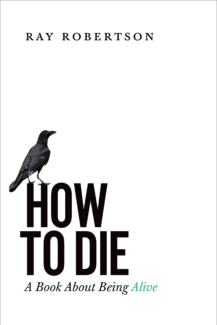Spotlight On: HOW TO DIE by RAY ROBERTSON
The Biblioasis Spotlight Series returns for another year! Kicking off 2023 is our January pick, Ray Robertson‘s philosophical and surprisingly heartfelt How to Die: A Book About Being Alive (Jan 28, 2020). Enjoy a brief note from the author on the themes of mortality in his works, and don’t miss an excerpt from the book in our newsletter later this month!
HOW TO DIE: A BOOK ABOUT BEING ALIVE
 “He who would teach men to die would teach them to live.”—Montaigne
“He who would teach men to die would teach them to live.”—Montaigne
In How to Die: A Book About Being Alive, Ray Robertson meets Montaigne’s challenge, arguing with characteristic candour and wit that if we gain a clearer understanding of death, we’ll also better understand life. Contending that human beings tend to prefer illusion to reality—and so readily flock to the consoling myths of philosophy, religion, and society—Robertson echoes Publius Syrus, the first-century Roman who claimed, “They live ill who expect to live always.”
An absorbing excursion through some of Western literature’s most compelling works on the subject of mortality, How to Die: A Book About Being Alive is an anecdotally-laden appeal for cultivating an honest relationship with death in the belief that, if we do so, we’ll know more about what gives meaning to our lives. Pondering death isn’t morbid or frivolous, Robertson argues—not unless we believe that asking what makes for a meaningful life is as well.
“While How to Die is a slim book, it offers some hefty insights, leavened with frequent, self-effacing humour. There are numerous passages here which, while quick to read (the book is very accessible, despite its philosophical bona fides), nonetheless take hours to fully internalize … Brilliant.”
—Toronto Star
Ray Robertson is the author of nine novels, four collections of non-fiction, and a book of poetry. His work has been translated into several languages. Born and raised in Chatham, Ontario, he lives in Toronto.
Grab your copy of How to Die here!
Check out Ray Robertson’s other books here!
Writing and Mortality
Writers are often the least likely to know what their own books are about. Or, if they’ve written a bunch of them, what the relationship between them is. That’s not their job—their job is to create worlds, not to analyze or explain them. It was during a conversation with Dan Wells, Biblioasis’ publisher, that I came to appreciate the elemental role mortality has played in my last several books. We were discussing my novel Estates Large and Small, which came out last year and a couple of years after How to Die: A Book About Being Alive, and Dan said something I hadn’t thought of before: among other things, Estates Large and Small was a fictional continuation of the exploration of death I’d embarked upon in the previous, non-fiction book. Basically, I wasn’t done with the topic, even though I thought I was.
I’ve never chosen a subject for a non-fiction book or a theme for a novel—writers don’t pick their obsessions, they pick them—and I’m always pleased when the book I’m working on insists upon going this way or that. I trust my books more than I do me. Estates Large and Small is about a second-hand bookseller who’s forced to shut down his brick-and-mortar bookstore and adapt to a brave new world of e-commerce, but it’s also about death: the death of a way of life, yes, but also about the ephemerality of all things, including ourselves and those we love. As in How to Die: A Book About Being Alive, I believe that contemplating death isn’t morbid or empty navel-gazing, but is a way to reflect upon life, and what death can teach us about living a better, more fulfilled existence. One of the two epigraphs I used for How to Die: A Book About Being Alive is an excerpt from Philip Larkin’s poem “Days,” and, as poets often do, Larkin encapsulates this big idea in the shortest of spaces:
What are days for?
Day are where we live.
They come, they wake us
Time and time over.
They are to be happy in:
Where can we live but days?
This year Biblioasis will publish All the Years Combine: The Grateful Dead in Fifty Shows, another non-fiction book. It’s about a rock and roll band and what makes their music, and particularly their concerts, so unique. A rock and roll band called the Grateful Dead. I wouldn’t be surprised if it’s about more than that.




